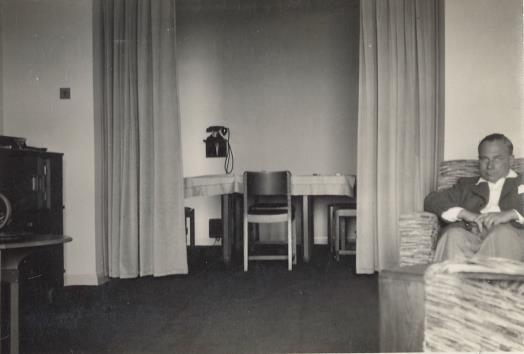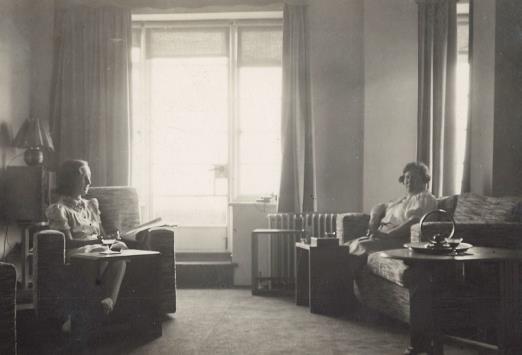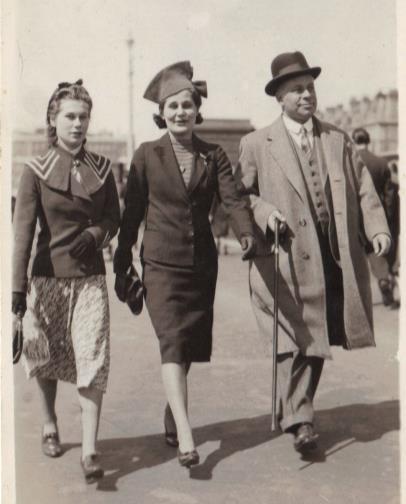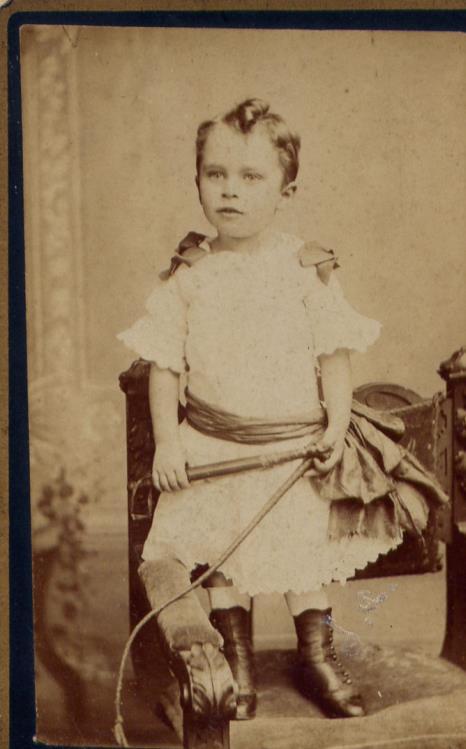
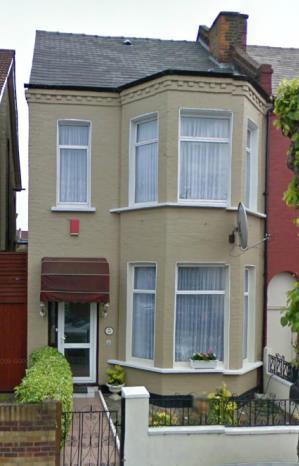
Despite my Grandfather, Walter Robert Howard, having lived until hewas almost97 years old, notmuch hasbeen knownabout his life by his descendants. This paper will attempt to rectify this, using various documents asevidence.Hewas thefirst child born to Walter, a labourer from Camp in St Albans. After agriculturalopportunitiesdeclinedinthenineteenthcentury,his father had become one of the thousands employed by the newly developing railway network. His family therefore had settled in the North London areaby the time that Walter wasborn. Within a year of marriage, as Ellen, his mother, was pregnant, they had moved from a house which they were sharing with a Railway Inspector at 37, Elm Grove Hampstead, to 23 Ariel Rd LondonNW62EAwhereGrandpopwasbornin1891onBastilleDay,July14th.Myabiding memory of him was his joking that whenever he was in Paris on business on this day the streets weredecorated withflagsfor his birthday. He was not baptised however until May 29th 1892 at Somers Town Presbyterian, St Pancras.
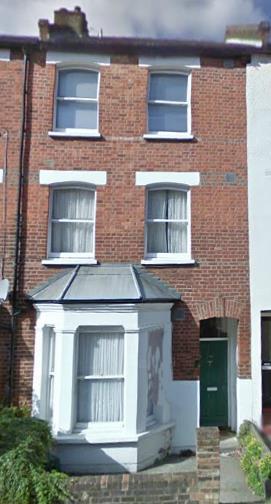
Although the house was 3-storied his parents lived in just two rooms, sharing the house with another nine people, thefamilyofaretired bronze chaser. Having moved to Marquis Place by 1892, they had moved yet again, to 37, St Paul's Rd in St Pancras, (now known as Agar Grove) by the time that Ellen was born in 1895.
Thiswas describedbyCharles Booth as working class in 1899. Booth’sreport mentioned that the areahadgonedownconsiderablysincemakinghispovertymap.In1907forexampleStPaul’sRoad was the scene of a notorious murder. Emily Elizabeth (aka Phyllis) Dimmock, a prostitute in her early20s,wasfoundonemorningwithherthroatcut.Didthistragiceventprecipitateyetanother
housemovefortheHowards?Althoughhouseshereweremainly3or4storiedonlythreefamilies now kept servants, proof of how much the neighbourhood had declined. High rents meant that most families here hadto sublet, theHowards included.

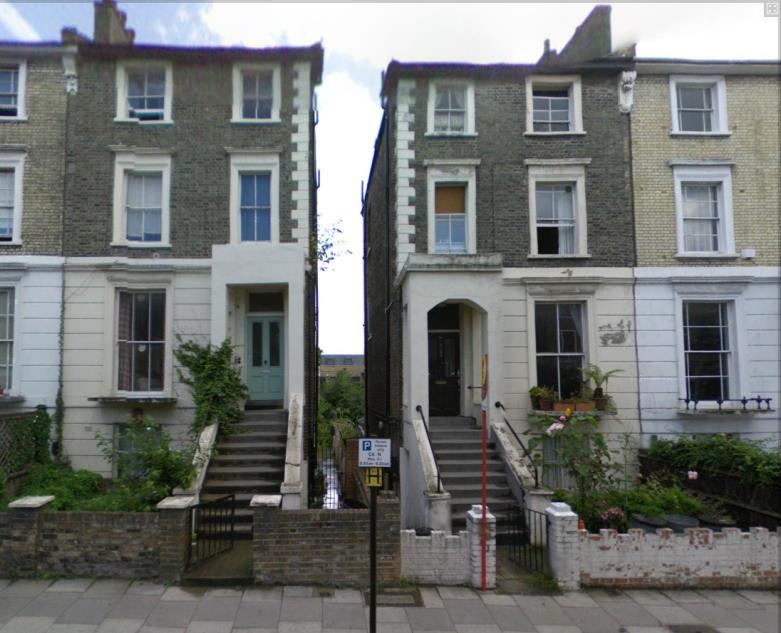
1910 Directory information about the St Paul’s Road area, Camden Town including Marquis Road which was nearby.
This new family group now comprised Walter, aged 35, a railway accountant born in St Albans, Ellen, his 36-year-old wife bornin Bloomsbury, Walter Robert their 9year-old son, whowasborn in West Hampstead, Ellen Maud their 6 year old daughter born in St Pancras, and Albert John, their 1 year-old son also born in St Pancras.
Map of Camden in London showing various places lived in by Walter’s family. Microsoft Corporation Houses in today’s Agar Street.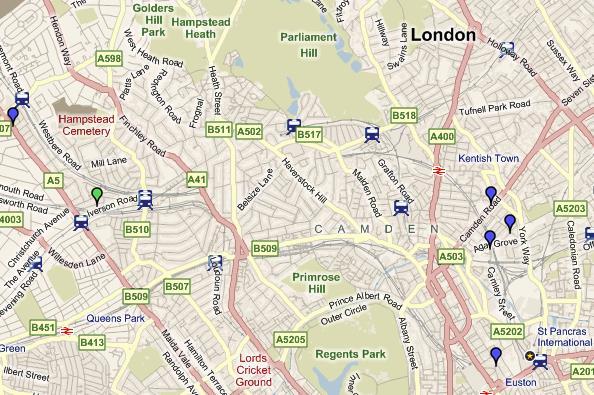
Elm Grove Ariel Grove where he was born Marquis Road
St Paul’s Road
Presbyterian Church where his father remarried.
Somers Town Presbyterian where Grandpop was baptised and where his parents married.
All these homes were convenient for his father as he worked for theLNER out of Euston for about 40 years.
In1911Walterwasstilllivingathomewithhisparentsand siblings, they having now moved to 19 Marquis Rd, an end of terrace house, and was working as a civil engineer's clerk. His father was a Railway Clerk, Ellen a dressmaker and Jack was still a schoolboy. They lived in four rooms, whilst a widow and her son lived in the three other rooms. Mum remembers their living mainly in the basement. His family had very little money so, although he had won a scholarship to study at Oxford, he was unable to go, as his father said he could not afford to 19 Marquis Road
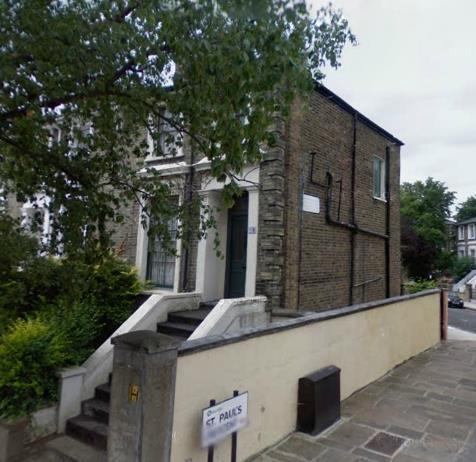
subsidise his social life there and it would be unfair to his brother if Walter went and Jack did not. Despite this, Walter continued his education, attending evening classes most nights to learn French, and eventuallyqualified as a chartered structural engineer.
Prior to WW1 hewas a Royal Naval Volunteer reserve. Awarethat theRNR could not supply the required number of trained men at thestart of the 20th century, because the Navy was rapidly expanding, a scheme was introduced that allowed men in civilian shore jobs, unconnected with the sea, to train on a part-time basis atspecialshore establishments. This provided thevaluable experience of real time with the Fleet for a few weeks a year once a certain level of competence had been achieved.
Formed under the Naval Forces Act of 1903, and first known as theRoyal Naval Volunteer Reserve, five divisionswere established in Bristol, London, Tyne, Mersey and Clydewhere civilian volunteers trained in old Fleet warships. RNVR uniform was distinguished by its wavy gold lace, leading them to be affectionately known as the 'Wavy Navy' because therank stripes on officers’ sleeves were wavy rather than straight.1
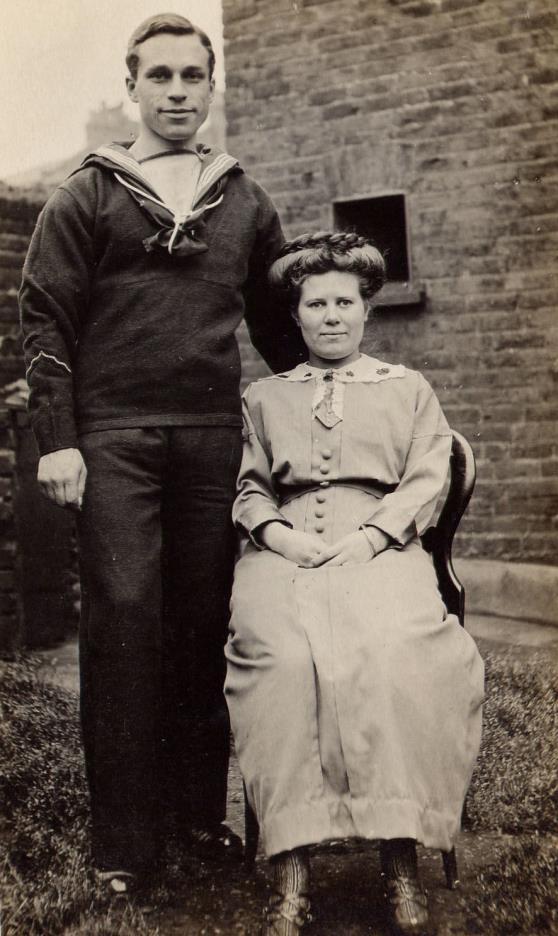
He was atsea the daywar broke out in Britain on 4Aug 1914, on Bank Holiday Monday, and so hebrought forward his marriage to Olive. Arthur, his grandson, remembers Grandpop showing him his leave permission to getmarried as hehad keptit in his wallet for over sixty years. By 20th Aug 1914 he hadbeen discharged at his own request as Mouchel, the company heworked for, said his occupationwas important to the war effort and so had asked that hebe released.
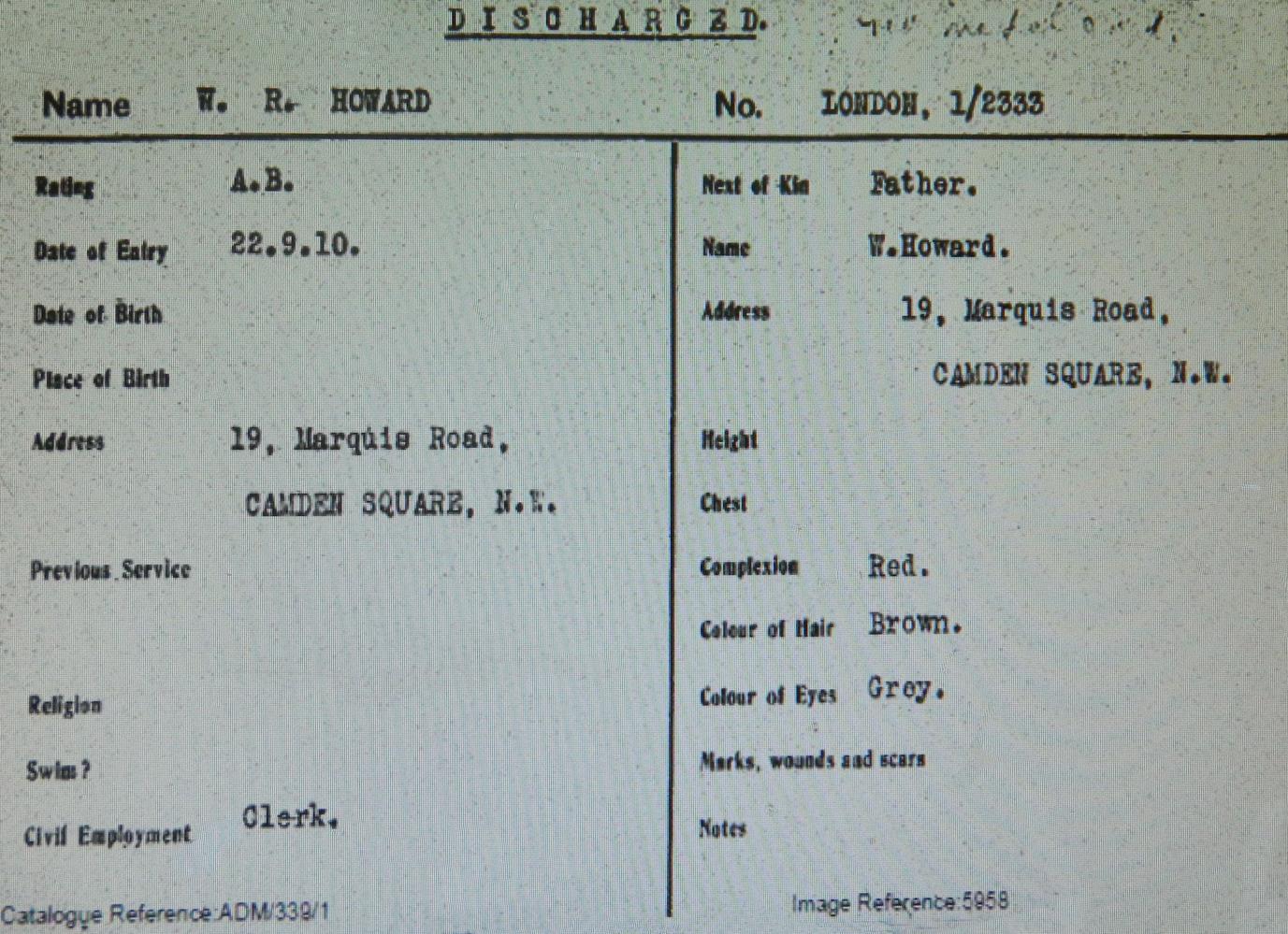
Admiralty and War Office: Royal Naval Division: Howard, W R Rank orRating: Able Seaman Service Number(s): 1/2333 Records of theAdmiralty, Naval Forces, Royal Marines, Coastguard, and related bodies ADM 339/1/18483
He was described as having a red complexion, brown hair and grey eyes and was a clerk when he signed on in 1910.
Walter met hisfuturewife,OliveAshTravers, atSomersTown Presbyterian Church wherethey bothsunginthechurchchoir.WithintheChurchtheybelongedtoaMutualImprovementSociety in which Walter, Olive and his sister Ellen were committee members. The syllabus for 1913 included a talk on an essay “The Rise of the English Novel” by Miss Howard, i.e. Ellen, on January 30th, and a lecture on “The EvolutionTheory” on Thursday 6th February by MrW. Howard.
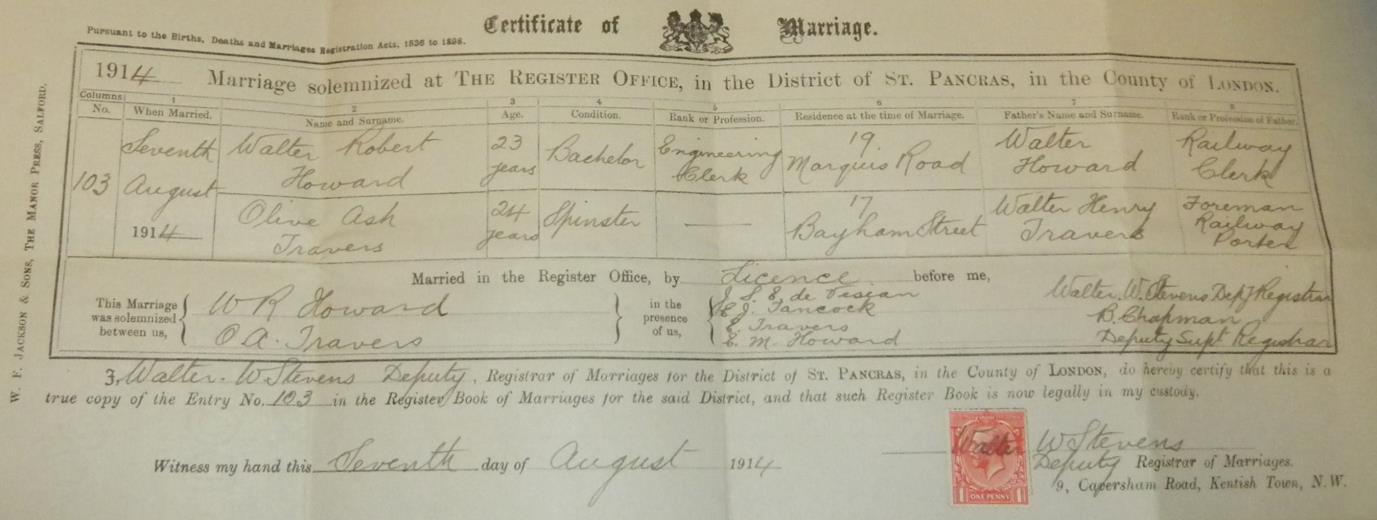
August 7th 1914 marriage at theRegister Office in St Pancras.
Official photos of thewedding, taken later, indicated how quickly it was arranged as little attention was given to the setting: the back garden of Marquis Road included a dustbin in the background. Walter was still living at home but Olive was sharing a room at17, Bayham St., Camden Town, London with her sister Edie. His father remained in his home until his death in 1941, but Olive’s father had remarried and lived at 86, Pancras Square, St Pancras and later at 75, Minet Ave, Willesden, Middlesex where hedied in 1935 Bridesmaids wereEllen Howard and Edie Travers, with witnesses to themarriage being Lieut. Colonel de Vesian thefounder of Mouchel, Ernest Tancock, Ellen Howard, and Edith Travers.
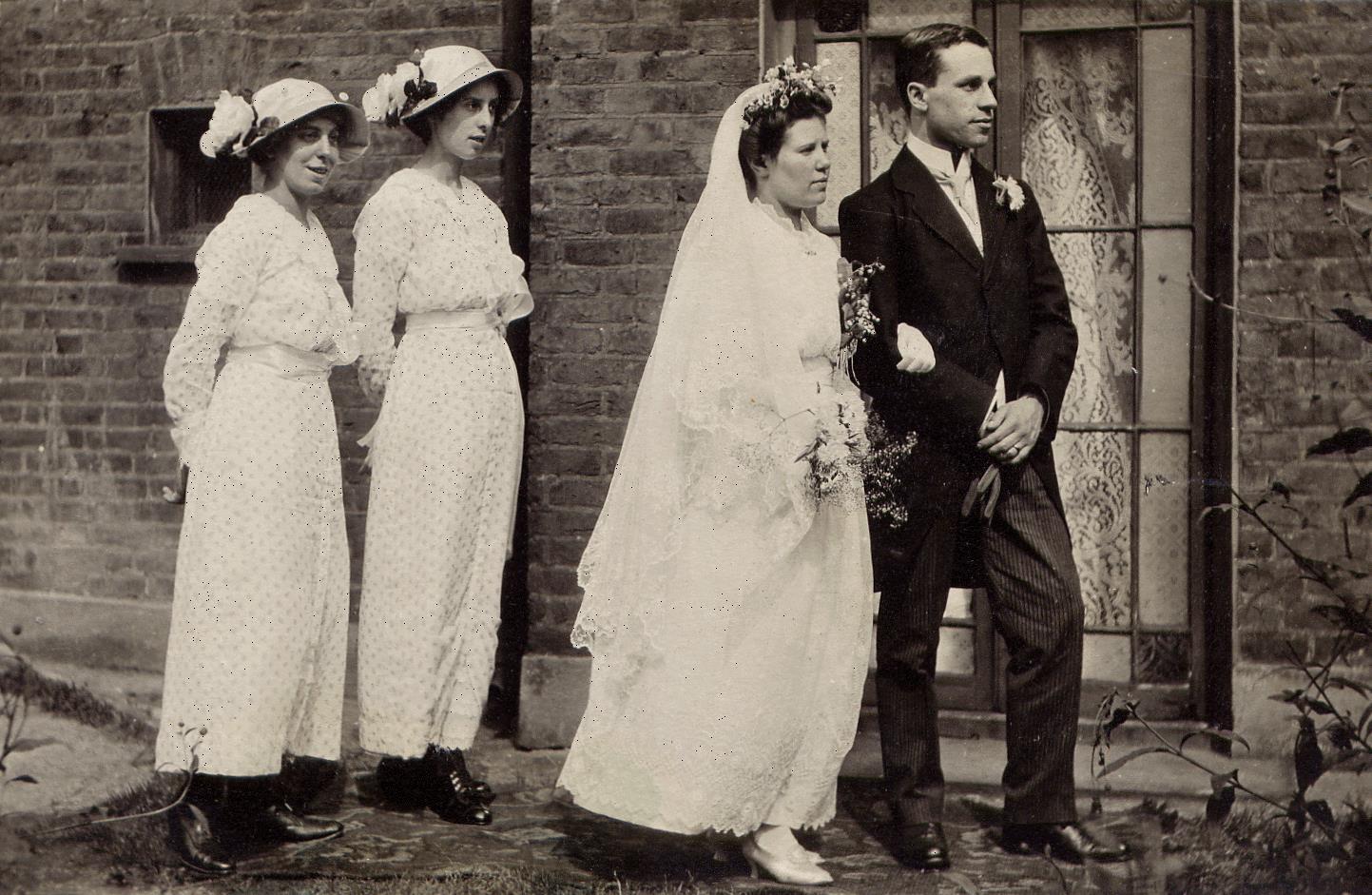
Their bridesmaid Edith Ophelia Travers later wore this ensemble to the wedding of her future husband’s sister Florence Cain in 1915.
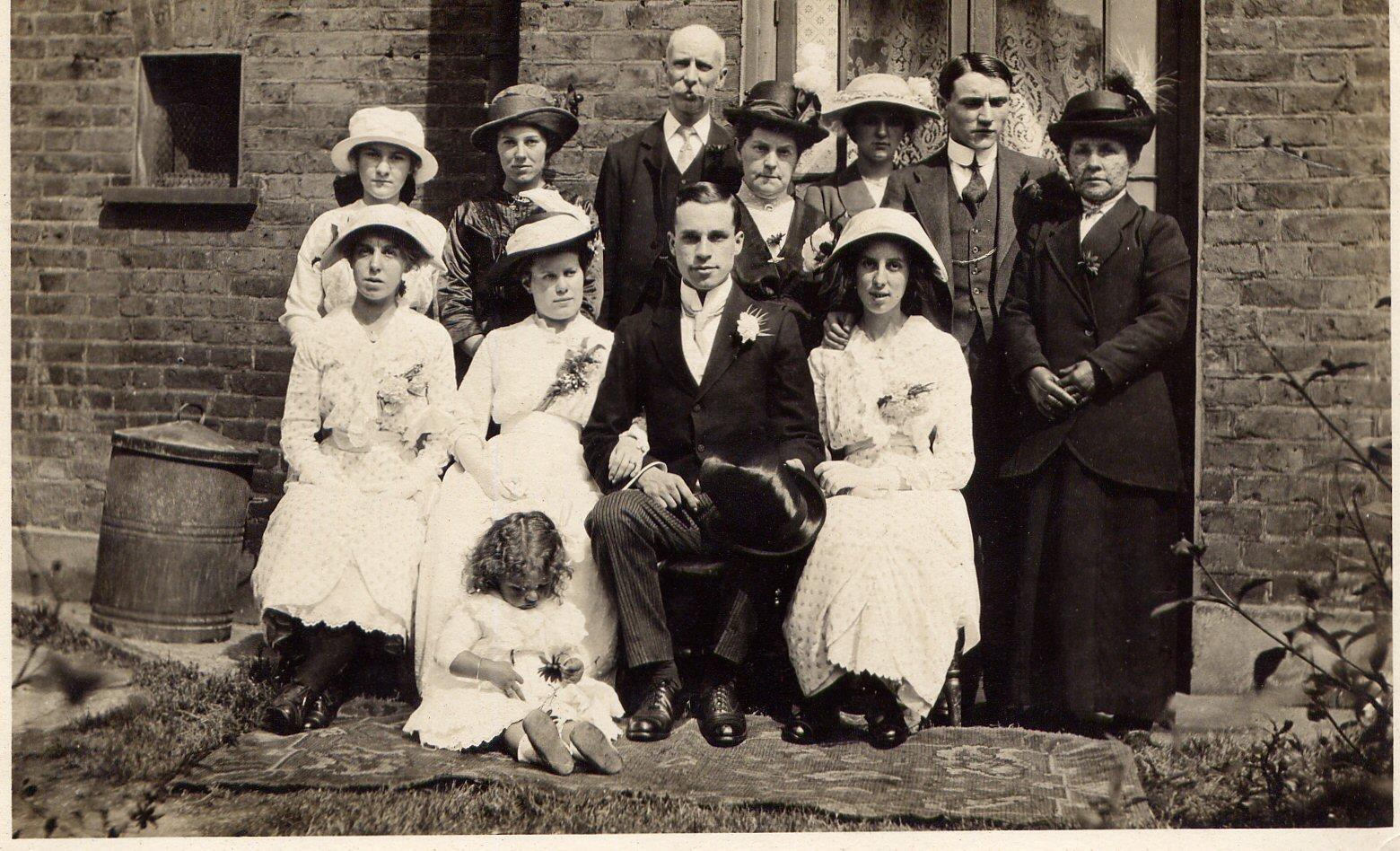
On the left by Olive are Alice and Edie, with Alice Lavinia’s 2-year-old daughter Joan in the foreground. On Walters’s side are Ernest Tancock with his arm on Ellen Howard, and his mother, Mary Ann Inge. Others included Walter Howard senior (with moustache) in front of his wife, Ellen née Gooch and Jack who was in another photo.

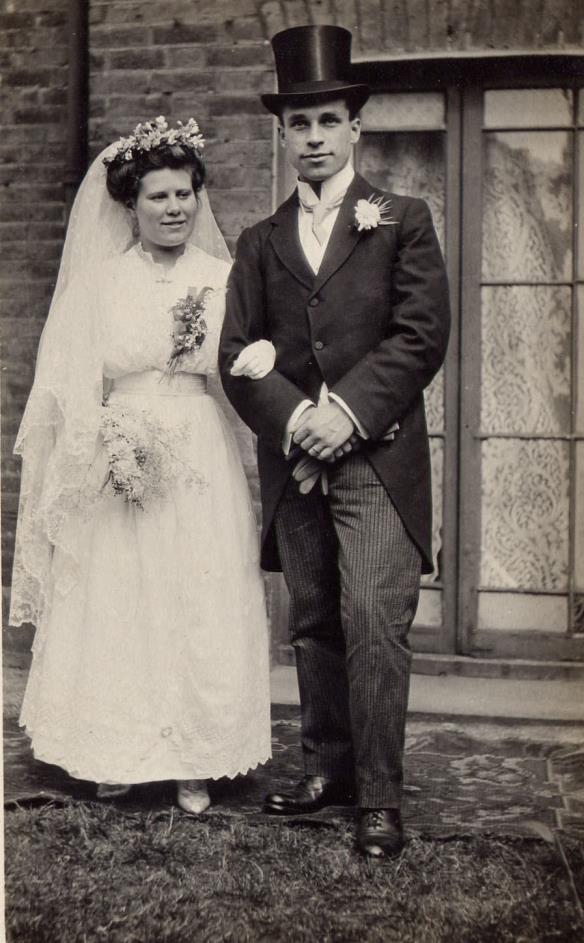
A photograph of him holding his daughter Olive ather baptism shows him wearing akhaki-drab armband with a red felt crown. TheEarl of Derby introduced what was
called the Lord DerbyScheme on 16th October 1915 wherebymen could volunteer for the forces but then returnto their jobs until theywere formally called up. They completed one day’s service and werethen placed on reserve.Whilst still working and waiting to be called up they were entitled to wear a grey arm band with a red crown to show that they had signed up to fight. Walter was not subsequently called up as far as we know.
Whilst in the R.N.V.R. he won a pewter mug weighing 1lb 4oz for rowing. He also enjoyed bowling for relaxation, but his main interest athome was as a family loving man, having three daughters, Olive May, Joyce Muriel and Lorna Phyllis.
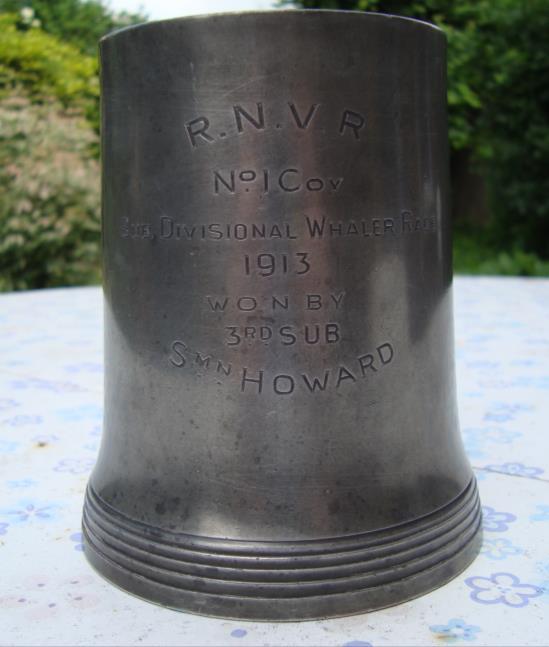


Howard family with Joyce, Olive, and Walter Howard senior talking to Alma and Cissie family gatheringswithseveralgenerationsmadeforhappy days and Olive Ash always led the way with a song.
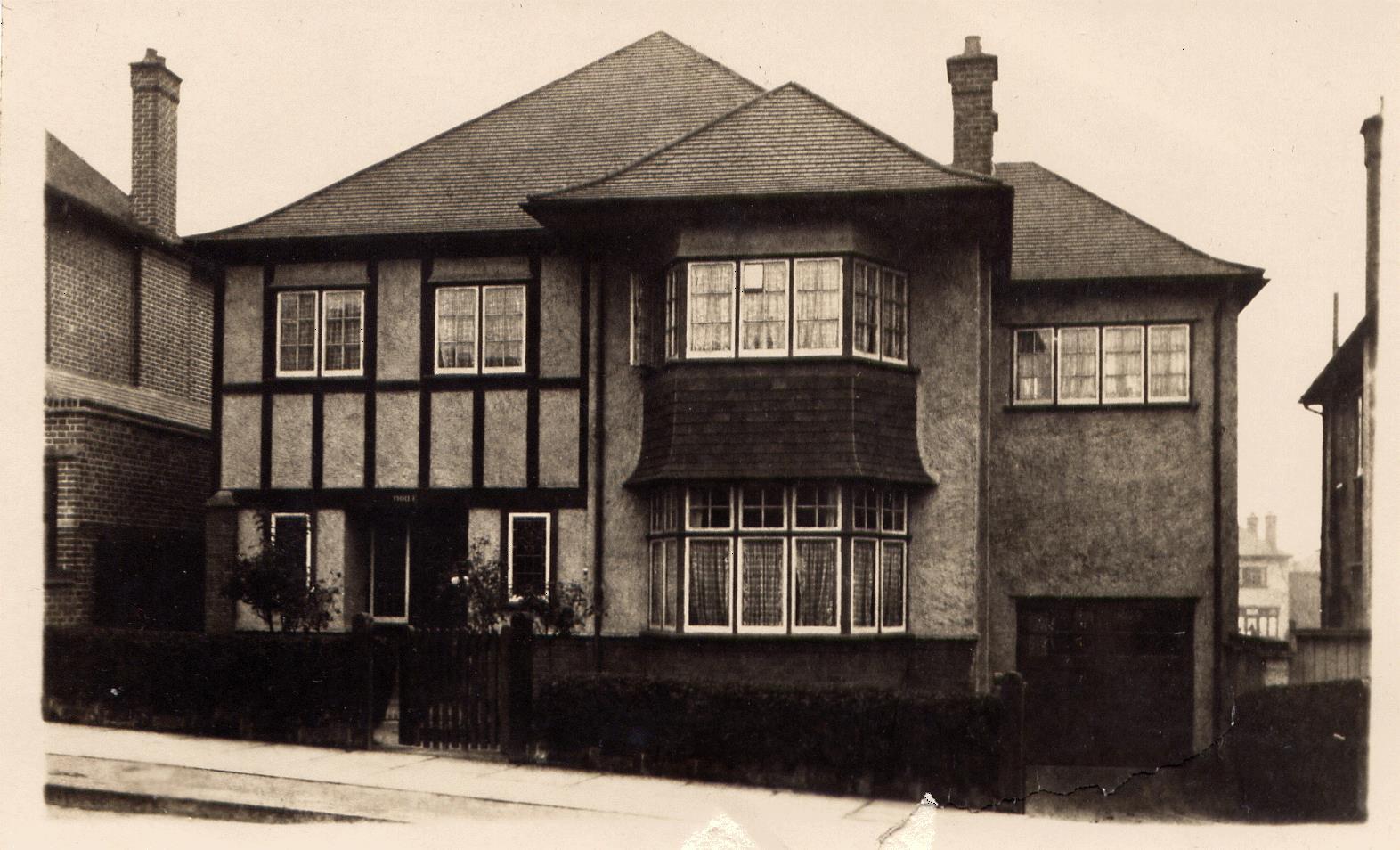
3 Graham Road. Walter’s den is above the garage. His bedroom is the double room at the front.
He lived atvarious addresses in London with his family, including 96, KilmartinAve, Norbury, SW16
17, Neeld Crescent, NW4 phoneHendon 1235 and finally, from 1930 to 1979,
3 Graham RdLondon NW4 3DH phoneHendon1235, later changed to 01-202-7239.
AsachildIdidnotthinkthathewaswealthybecausehetoldmethatthegovernmenttook19/6d tax out of every pound that he earned! I felt so sorry for him. Despite this so called poverty he frequently took his family on cruises, and when grandchildren were born they would then spend Christmasinvariousseasidehotels,includingEastbourneandMargateandtheGrandatBrighton, driven there by his chauffeur, Holt, who, Grandpop used to joke, did not know how to halt and so had fathered 12 children. His car registration was WOL for Walter he told me, but as this was changedfrequentlyIthinkthiswasyetanotherofhislittlejokes.TheRollsRoycecarsbelonged to his company and the fleet was added to every year at one period until each member of the board had one, the Chairman always having thenewest one. Theyear that all the board had their Rollers and WRH turned up at his bowls club in the same car as the previous year, his friends in the club teased him by saying he had let theside down.
Surprisingly, to me, considering my assumption of their poverty, Walter and Olive took foreign holidays every two months, as well as travelling extensively for business. I have found several references on the Internet to his voyages. On the 22nd July 1939 Walter and Olive went on a Polytechnic tour to New York. They left from Southampton and travelled via Cherbourg to Quebec, Canada, ontheEmpressofBritain, ashipintheCanadianPacificline,arrivingonJul27th 1939.WhilstinNewYorktheystayedattheMcAlpinehotel,thelargesthotelthereatthattime, arriving on August 1st 1939 at Niagara Falls, New York, USA. On August 17th 1957 he and Olive sailed first class on the Antilles, on what he called the “banana boat”, to the West Indies. He returned for another visit on August 5th 1958 on the Camito, a boat owned by Elders and Fyffes Ltd. To his grandchildren this sounded very exciting, and I was impressed by the necklace made of real seeds which Grandma brought back for me. Even after Olive died in 1967 Grandpop continued with these holidays, especially enjoying cruises in Europe on the Rhine and various French rivers.
In 1919 Walter formed the Helical Bar & Engineering Company Ltd., using money provided by Mouchel to set up the office.
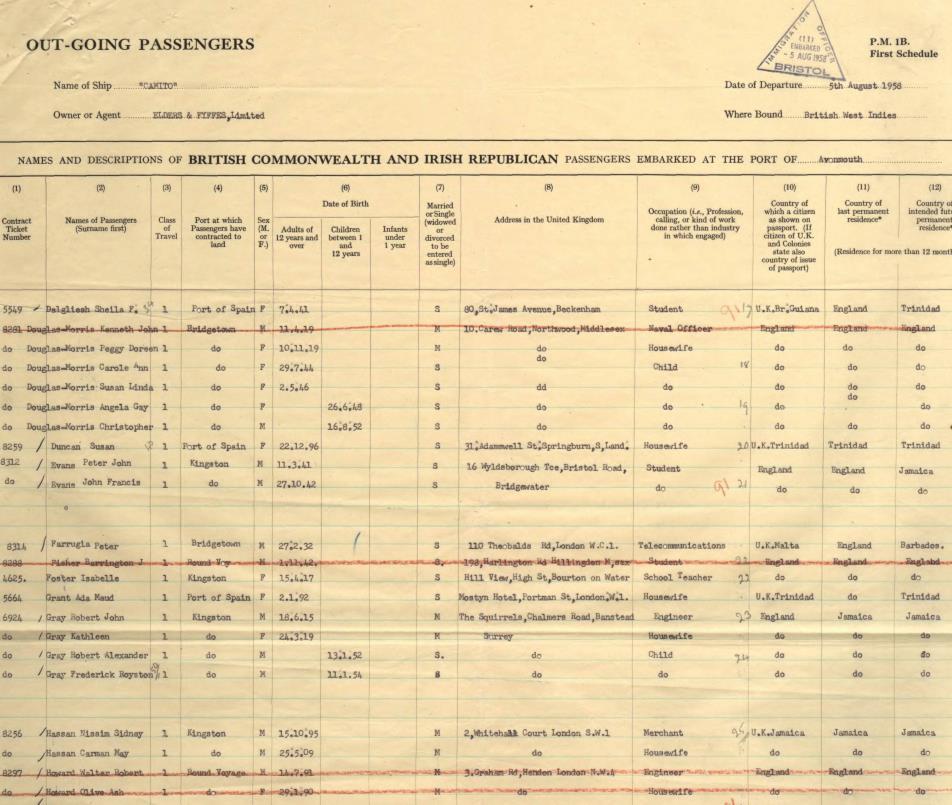
From 1925 to 1945 he was a partner in the firm L. G. Mouchel & Partners, Structural Engineers, based in Westminster, London.

He was Chairman and Managing Director of the Helical Bar & Engineering Company Limited which was later incorporated as a limited company on 3rd July 1919. It was a specialist company in the design, supply and erection of ferro-concrete structures and of reinforcing steel for the construction industry. In addition he was also Chairman and Managing Director of the London and Provincial Asbestos Cement Co. Ltd, and of W. RHoward & Partners Ltd.
Prior to the Second World War he was awarded the Palmes d'Academie and was nominated Officierdel'InstructionPubliqueforworkhedidinFrance.During WW2 his offices in Victoria were used by General de Gaulle as Walter worked in close liaison with the Free French committee in London. We suspect that he was a member of the Special Ops as agents reported to him when they came out of France. At the conclusion of the hostilities he was awarded the Medaille de la Reconnnaisance Francaise. In 1955 the French ambassador nominated him for the Chevalier de la Legion d'Honneur for his services in connection with developing Structural and Civil Engineering contacts between France and Great Britain. Buckingham Palace confirmed that these medals, conferred by the President of the French Republic, could be worn with restricted permission in public. Walter refused a Commission and turned down the honour of being a Colonel as he wanted to keep a low profile, but was invited twice to Buckingham Palace Garden Parties.
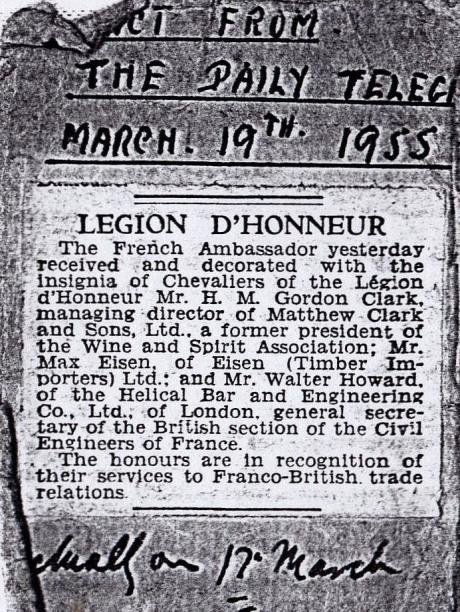
Moucheloriginallyopenedanofficeat124,Holborn,London,butbeforelongmovedto38,Victoria Street where the company remained for 59 years until 1957 when they moved to premises
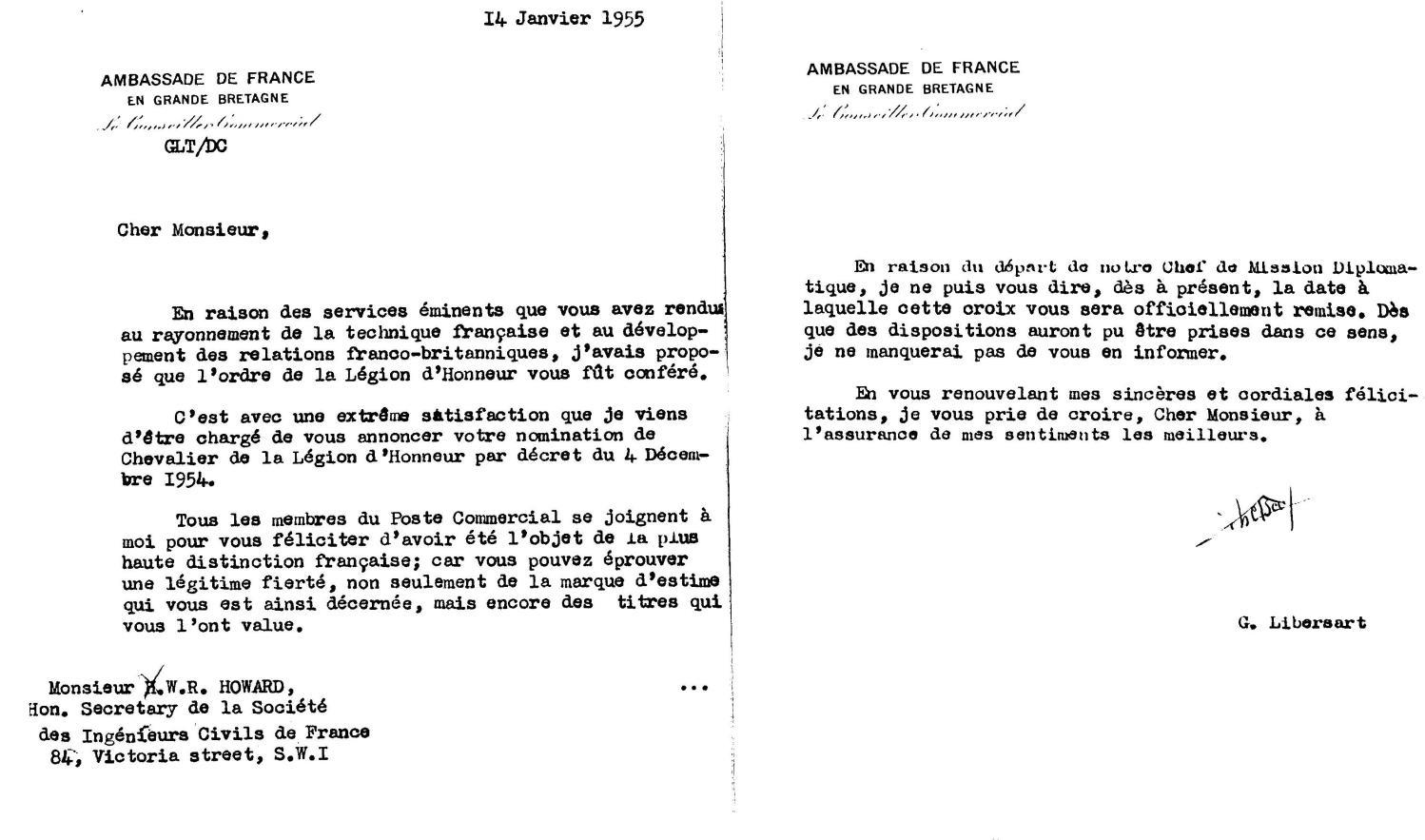
overlooking the river at 82,Victoria Street. Meanwhile Helical Bar and Engineering Company Limited was now situated at 72, Victoria Street, London, S.W.1. WWIIsaw the company move fromLondontoSutton,movingbacktoVictoriaaftertheblitz.WalterownedaflatinHove,near Brighton, 18, Viceroy Lodge, Kingsway, Hove, opposite the King Alfred Training Centre for the naval RNVR Officers. In the summer they lived here but after war broke out, and finding the train line up to London susceptible to bombing they all moved back to Hendon as he needed to be in the office every day. Back in Hendon Walter also worked parttime as anAir Raid Warden.
HeheldmanypublicpositionsincludingFellowoftheInstitutionofStructuralEngineers,F.Inst.D, Vice President and Treasurer of the Society of Engineers, Past President of the Society of Engineers, Membre de la Societe des Ingenieurs Civils de France, Past President of the British section of the Societe des Ingenieurs Civils de France; Vice President of the London branch of L'Alliance Francaise en Grande Bretagne; member of various technical and trade associations including the Architects Registration Council, Vice-Chairman of the Admission Committee, the Architects Registration Council, Vice President of the British section at the World Technical Conference and Ordinary Secretary of theBritish section of theIngenieurs Civils de France.He belonged to the Constitutional club the Royal Anglo-Belgian Club and the Directors no. 10 Club.
W. R. Howard on extreme right, present at a meeting with Winston Churchill. This was the year he was Vice-President.
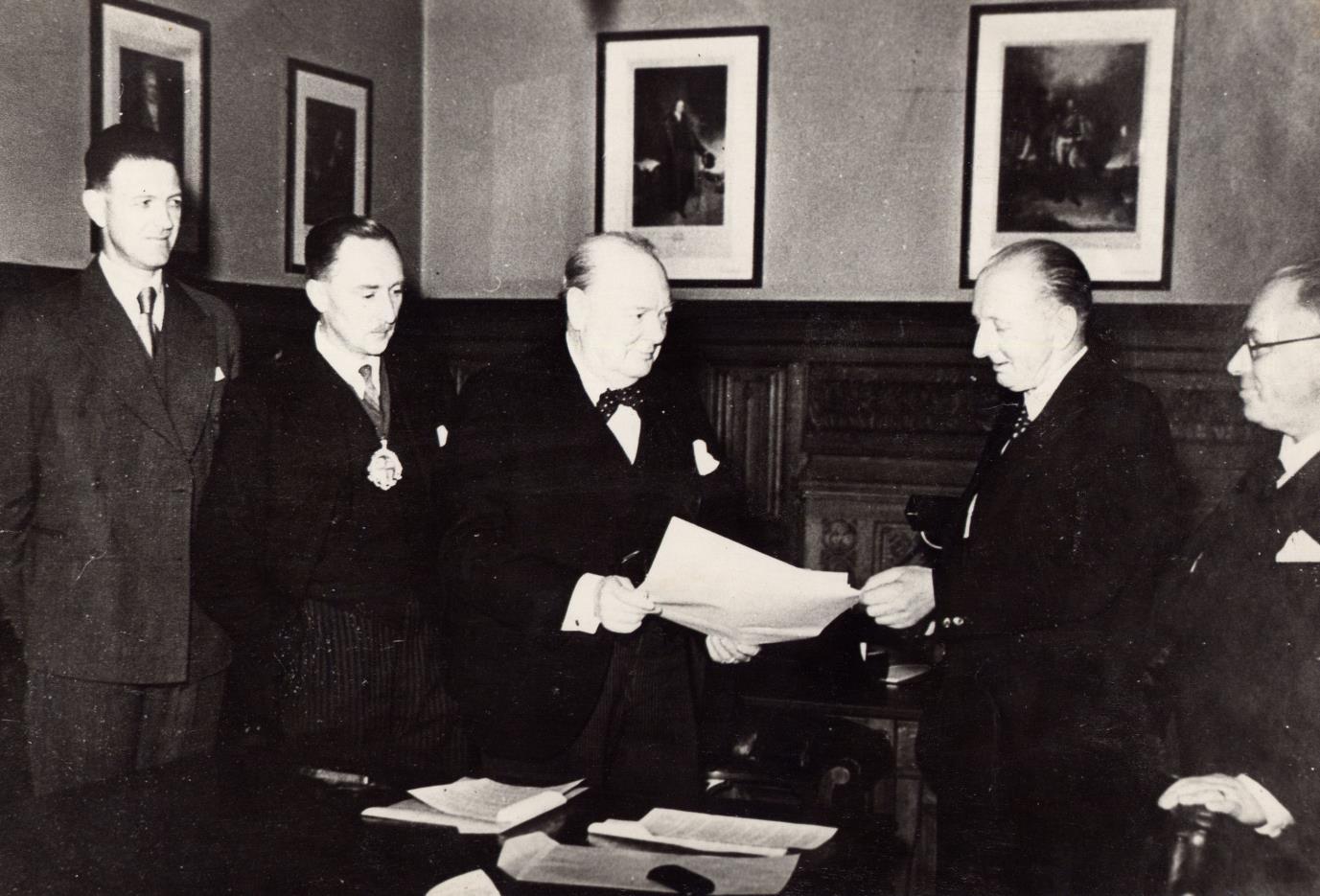
Mouchel was involved in the design of the 115 huge caissons, 204 feet long by 60ft high and 50 feet wide, to form the six mile breakwater to enclose Mulberry Harbour, the greatest military engineeringprojectinhistory.ThiswastheartificialharbourwhichwasprefabricatedinBritain, towedacrosstheEnglishChannelandassembledofftheNormandycoasttoprovideportfacilities insupportoftheAlliedForceswhomountedtheinvasionofthecontinentinJune1944. Churchill famouslysaidofthis:“bringmethebestsolutions, donotwastetimetalkingabouttheproblems; they will take careof themselves.” http://www.combinedops.com/Mulberry%20Harbours.htm
These Floating Docks, constructed of reinforced concrete by Wates Limited to a Mouchel engineered design, were built 1942-1944.
Designed to last solely for the six month projected use of the harbour for the D-Day landings, some sections of the Docks can still be seen today on Arromanches beach. The 'Mulberry' piers were linked steel bridge units sitting on 'Beetles' (pontoons built of steel plate) to support a floating roadway for the unloading of equipment onto the Normandy beaches. The floating pontoons that supported the structural steel roadway were giving the Ministry trouble and the
Mulberry HarboursRoyal Navy was demanding huge quantities of steel plate resulting in a severe shortage for the floating pontoons so the War Office approached Mouchel to complete the requirement in concrete. The design, which produced a combination of pre-cast slabs and in situ concrete, requiredslabstobeonly1¼inchesthicktoobtainflotation. ThehugeMulberryundertakingwas carried out during the winter months of 1943 ready for the invasion of the continent in June 1944. Mouchel sent staff to the War Office to work on the huge reinforced concrete caissons. Some drawings were however done in the Victoria Street Office. They had to be designed to float,butoncesunktoresistfloatation, overturningandbreakingupunderstormconditions.The whole operation was to be conducted in the utmost secrecy. Amazingly, the huge concrete boxes were constructed all around the South Coast and in river estuaries without their true purpose beingdiscovered.Beinghighlyvisible, therewasconjecture thattheywerefortheproductionof masses of recently discovered penicillin for war requirements. With the firm's contribution to the Mulberry Harbours apparently completed, the staff involved returned from TheWar Office toVictoriaStreet.Fewmembersofthestaffknewwhattheyhadbeendoing,andthosethatdid werewarnednot totalkaboutit.Grandpop wasdecorated for thiswarwork.Thefirm'sofficein Victoria Street survived the German onslaught undamaged except for broken windows and, following Japan's surrender in August 1945, serving staff progressively returned to thefirm.
He kept a diary with many phone numbers in, which his daughters used to joke were of his girl friends as these included the Folies Bergere where one girl memorably said “ I nezzer says no”. He travelled frequently to France, both Paris and Nice, and attended International events such as the Chicago TradeFair in 1933.
In June 1967 after fifty three years of marriage, Olive died, leaving Grandpop alone and lonely. He couldn't face Christmas at his home that December so for the first time in years there was no family gathering at 3, Graham Rd. Instead, Grandpop went on a cruise with his sister Ellen to get away and she unfortunately died in an accident aboard ship on Christmas Day.
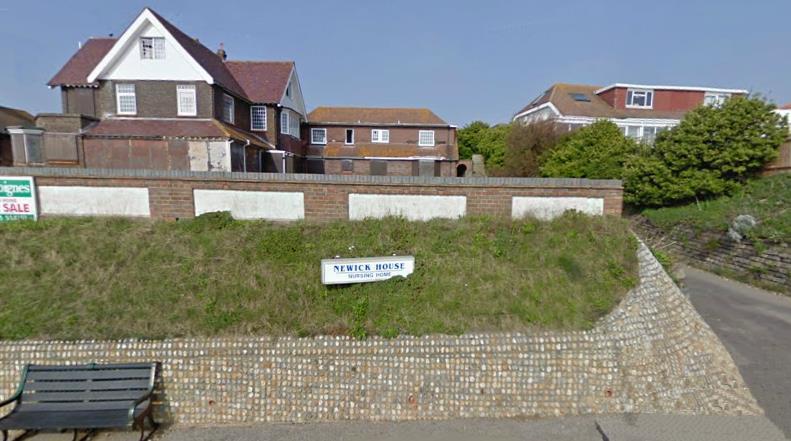
In 1972 Walter was operated on at Whittington Hospital as hehad prostate cancer and I feared that this was the end. However herecovered, carried on working until about 1975, being looked after by Olive who came over every day from nearby Kingsbury to cook for him. Though he once proudly stated that for thefirst time in his life hehad managed to boil an egg for his breakfast. However when she wentto visit her daughter Marleen inAmerica, leaving her sisters to share the care, Joyce realised that he needed more help thancould be given, and so the last ten years of Walter’s life were spent in Newick Nursing Home, 105 Marine Drive, Rottingdean, BN2 9GE Brighton, as it became apparent that he was suffering from dementia. Despitethis he could still converse in French andremembered driving to Brighton in the 1940’s.He was also aware that our car was a company one, as his mind was still sharp. He died in the home and was cremated at Golders Green Crematorium, North London on May 6th 1988 where his wife, their daughter, Olive and hisbrother had their ashes placed. He is commemorated in Bay 28, Tablet 30.
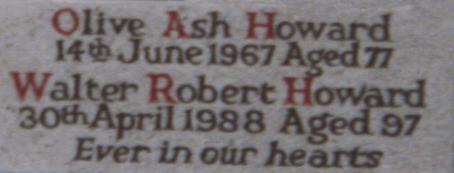
Daily Telegraph 1988: Walter Robert Howard aged 97, formerly of Hendon, London. Much loved father, grandfather and great grandfather. Funeral service Golders Green Crematorium, Friday May 6 2pm. An obituary was written in theTimes on May 8 1987. He was also known to his greatgrandchildren as Pop Pop.
Memories of Walter and Olive June 2011 I asked various people who knew him what they remembered about him. Did you talkmuch to Pop when you were little? What were your impressions of him?
Bert Hooper – whoused to take Edie to Graham Road to visit her sister Olive whilst Bert was working in theHighgate Depot, probably in thelate 1950s and early 1960s. He remembers Walter as being ‘gruff’and genial, friendly andnot snobbish. He mentioned that he had something to do with building the Maginot line…is this true? Work on this began seriously in the 1930’s, which may explain why Pop was awarded certain Frenchmedals prior to WWII
Alan Cain – remembersWalter and Olive as always being friendly and bringing clothes for the Cain family. Onetime they arrived at their home in Reede Road, Dagenham, in their car, and packed everyonein to visit Uncle Jack in Maidstone. Alan was impressed as at thattime it was unusual to see cars in Dagenham. When the family knew that Walter and Olive were coming to visit the house wouldbe cleaned and thefirelit in preparation.
Margaret Hooper and Peggy Cain. Olive andWalter had been given a beautifully carved chaise longue as a wedding present (according to Aliceit was an antique at the time, about 75 years old, and originally had been covered in rose damask). Olive gave this to Edie to help furnish their council house in Dagenham but it is now in Margaret’s house).
Margaret C– I remember grandma Edie tellingme as a girl that she told Olive ‘you look 11 months pregnant’ this was in the last fewmonths of Olive’s life when she had put on weightprior to having a stroke. Walter and Olive told Ediethat they were really pleased to have Frank as a son in law, the only onenot to want theHoward money.
Peggy recalled that Olive had also given Edie money, probably in the late 1920s and 1930s, and when Alan Cain was born in 1928 Olive and Walter asked to adopt him as they wanted aboy. Walter adapted well to his meteoric rise in society, however Olive found some aspects difficult. There was a time when Walter and Olive’s marriage was under stress and Walter had asked for a break. As we know they stayed together, but in separate bedrooms.Walter told Edie that he was really pleased to have Frank as a son in law, the only onenot to want the Howard money. Pat Cain– both directlyand asmemories from Edie.
Walter was like ‘Mr Pickwick’, short and fat! He was a pacer, walking up and down theroom, saying h’rm, h’rm. He liked Claire: when, as a young child, she had a new pair of shoes of which she was very proud, hetold her he didn’t have any new shoes. She told him that next time she would buy him a pair ofshoes. Walter took theCain family en masse (not sureif it was all 7) in the car to Southsea to visit Olive’s brother Will Travers, and to Maidstone to see Olive’s other brother Jack. Pat remembers sitting on thefloor of the car, which appeared to be the only car in thestreet. Even though “weknew we were the poor relations”, Pat remembers going to Graham Road, probablywhen Edie was ill, and noticed the difference which, as a child, she hadn’t observed. On her first visit to the house in Graham Road she had passed the house as it wasn’t as grand as shehad remembered. However Pat never felt that Walter had feelings of superiority. In the 1950s there was an articleand caricature of Walter, on theback page ofthe Evening News business section that Edie cut out and kept. At Edie’s funeral in March 1969
Walter arrived in his Rolls Royce without his chauffeur and as hewasnot used to driving he followed the hearse and upon returning took Peter Jefferey’smother with him in case he got lost.
Barbara Cain thinks that the Cain family didn’t mix much with theHowards but she recalls the Howard car coming to Dagenham. Sometimes they would arrive when the children werein bed and in themorning there would be thesmell and the discarded paper of fish and chips.The adults would also have had a drink atthe pub. In their younger days Olive and Edie would chat away together but William Cain was extremely quiet and if Alicewas around no-one else would have an opportunity to talk.
As hegot older, Walter seemed to become distant. At Barbara and John’s wedding hegave them a lift to their house in Barking.
Lorna Hayden. Until his retirementPop always seemed aloof, and only took notice of me once when he tickled me mercilessly. He shaved with an electric razor in hisbedroom, furnished with a massive mahogany suite including a half tester bed which I loved to jump on.
He never had much to say until I wasmarried and I tookmy two eldest to stay with him for a few days. I think he was intimidated by all his women.
Christmas wasn’t the same after my mother remarried and we nolonger went to hotels. Olive then took over cookingat 3, Graham, apartfrom once when she wentto America for a visit to see her daughter, and Arthur Hayden,my brother, and I, produced the meal for, as far as Ican remember, twelve people. Uncle Jack and AuntAlma always came to these parties.
Arthur, his grandson. Grandpop only spoke to me twice.
In 1919 heformed theHelical Bar & Engineering Company Ltd, usingmoney provided by Mouchel to set up the office, and from 1925 to 1945 hewas a partner in the firm, L. G. Mouchel & Partners, Structural Engineers, based in Westminster, London. He held many public positions and achievements, including Fellow of the Institution of Structural Engineers, Vice President and Treasurer of theSociety of Engineers, Past President of theSociety of Engineers, Membre de la Societe des Ingenieurs Civils de France, Past President of the British section of the Societe des IngenieursCivils de France; Vice President of the Londonbranch ofL'Alliance Francaise enGrande Bretagne; member ofvarious technical and tradeassociations including the Architects Registration Council, Vice-Chairmanof theAdmission Committee, theArchitects Registration Council, Vice President of theBritish section at theWorld Technical Conference and Ordinary Secretary of the British section of theIngenieurs Civils de France. He belonged to the Constitutional club; theAnglo Belgian club and theDirectors no. 10 Club.
Walter Robert Howard, F.I.Struct.E., P.P.S.E., M. Soc.C.E. (France) F.Inst.D. was Chairman and Managing Director of the Helical Bar & Engineering Company limited. Helical Bar was incorporated as a limited company on 3rd July 1919, and werespecialists in the design and erection of ferro-concrete structures and in the design and supply ofReinforcements. He was also Chairman and Managing Director of theLondon and Provincial Asbestos Cement Co. Ltd, and of W. R Howard & Partners Ltd. Originally known as the Helical Bar and Engineering Company Limited its main business was themanufactureand sale of reinforcingsteel for the construction industry.
Mouchel originally opened an office at 124,Holborn, London,but shortly moved to 38, Victoria Street where the company remained for 59 years. Mouchel was involved in thedesign of the115 huge caissons 204 ft long by 60ft high and 50 ft wide to form the six mile breakwater to enclose Mulberry Harbour for D-Day. Designed to last for thesixmonth projected use of the harbour, some can stillbe seen today. The'Mulberry' piers were linked steel bridge units sitting on 'Beetles' (pontoons built of steel plate). These Floating Docks, constructed of reinforced concrete byWates Limited to a Mouchel Design, were built1942-1944. Mulberry piers supported a floating roadway for theunloading of equipment onto the Normandy beaches. Thefloating pontoons that supported thestructural steel roadway were giving the Ministry trouble and the Royal Navy was demanding huge quantities of steel plate resulting in a severe shortage for the floating pontoons so theWar Office approached Mouchel to complete the requirement in concrete. Thedesign, which produced a combination of pre-cast slabs and insitu concrete, required slabs to be only 1¼ inches thick to obtain flotation. Thehuge Mulberry undertaking was carried out during thewinter months of 1943 ready for the invasion of the continent in June1944. Mouchel sent staff to the War Office to work on the huge reinforced concrete caissons. Some drawings were however done in the Victoria Street Office. They had to be designed in theshortest possible time to float, but once sunk to resist floatation, overturning and breaking up under storm conditions. Thewhole operation was to be conducted in the utmost secrecy. Amazingly, the huge concrete boxes were constructed all around the South Coast and in river estuaries without their true purpose being discovered. Being highly visible, there was conjecture that they werefor the production of masses ofrecently discovered penicillin for war requirements. Few members of thestaff knew what they had been doing, and those that did werewarned not to talk about it. Grandpop was decorated for this war work. The firm's office in Victoria Street survived theGerman onslaughtundamaged except for broken windows and, followingJapan's surrender in August 1945, serving staff progressively returned to the firm.
By 1907 patents on reinforced concrete were running out or being challenged so Mouchel hadto face the loss of his monopoly. Such was his reputation that commissions continued to flow in, so he turned his business into a limited company, L. G. Mouchel and Partners Ltd. and directed that his holdings in the company be offered to thestaff atpar and ever since the company has effectively been owned by thestaff. Mouchelfloated on theLondon Stock Exchange in 2002 and in September 2003 merged to form Mouchel Parkman plc; the company quickly established itself as a credible force in each of its core markets. Since then thecompany has been going from strength to strength with offices acrossthe UK, and in Ireland,the Middle East and Africa. Helical Bar continued for over 65 years but financial difficulties led the Company to seek new activities and on 21stAugust 1984 Michael Slade was appointed to the Board, bringing with him over 15 yearsof experience of thecommercial property world. The subsequent saleof the steel reinforcement business to its management at the end of 1986 left Helical Bar as a
property development and investment companywith Michael Sladeas its Managing Director and Nigel McNair Scott as its Finance Director. Gerald Kaye joined theBoard in 1993 as Development Director and Michael Brown became Investment Director in 1998.
At Buildings associated with Mouchel.
Royal Liver Building 11 May 1908 - 19 July 1911
Michelin Building October 1909 - December 1910
Sheath Lane(Oxshott)Footbridge 1908 - opened January 1910
Spanish City 1910
New North Road Bridge 1912 - 1914
Fiddler's Elbow Bridge, Newark 1915
Cooling Towers, 1924At Lister Drive Power Station in Liverpool, L.G. Mouchel & Partners provided theUK with its first natural draughthyperbolic-curved reinforced concrete cooling towers introducing the distinctive shape with which we are now so familiar.
Caversham Bridge Caversham Road, Reading assoc. engineer LG Mouchel & Partners March 1924 - 25th June 1926
Royal Tweed Bridge Royal Tweed Bridge River Tweed, Berwick-upon-Tweed, Northumberland associated engineer LG Mouchel & Partners date 1928
Earl's Court ExhibitionCentre (1937) LG Mouchel & Partners date 1935 - 1st September 1937
Nunn's Bridge, Fishtoft 1947 – 1948
Other significant projects included Royal Victoria Dock, and stands for Liverpool and Manchester City football clubs. The company also designed the cooling towers for Battersea Power Station, which form theskyline of London south of theRiver Thames.
More information can be found here: http://freespace.virgin.net/barry.d/history/recent_meetings.html http://www.mouchel.com/about_us/history/default.aspx accessed Oct 1 2009
Fearing that his home and office wouldbe bombed, in 1939, Walter moved his family to Hove, but his work in Londonwas vital to the war effort so they soon returned to 3,Graham Road.
